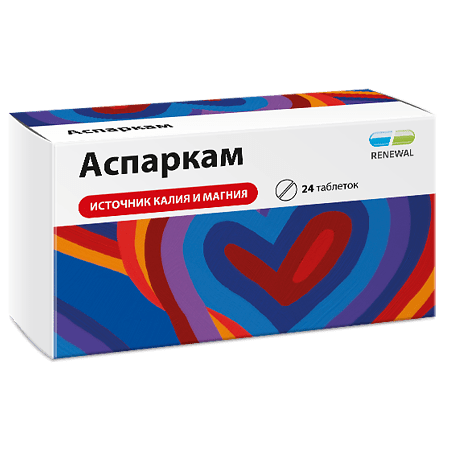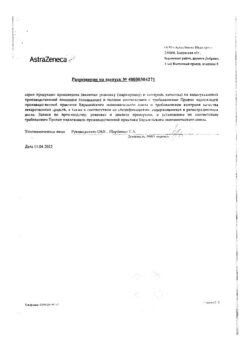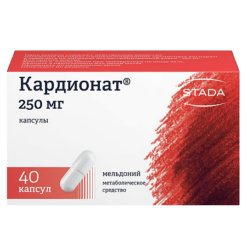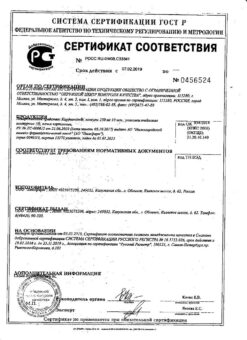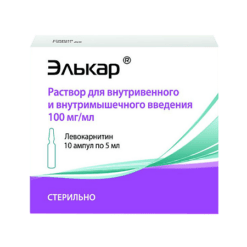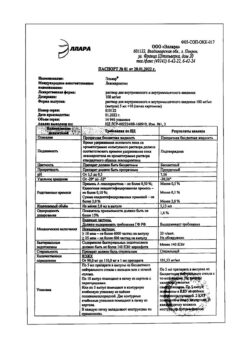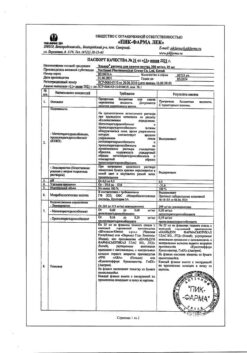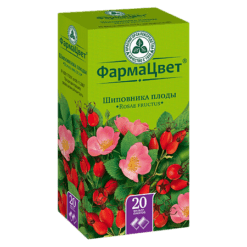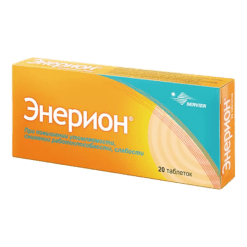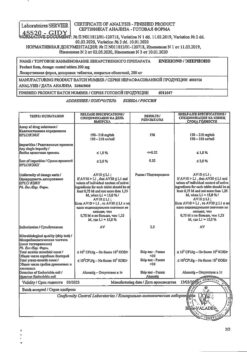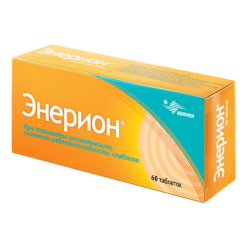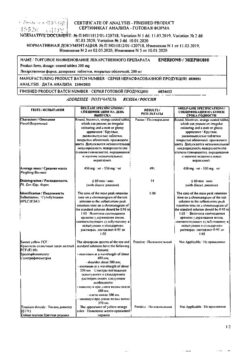No products in the cart.
Asparkam, tablets 24 pcs
€2.12 €1.93
Description
Asparkam is a source of potassium and magnesium ions, regulates metabolic processes, promotes restoration of electrolyte balance, has antiarrhythmic effect.
Potassium ion is involved both in conducting impulses along the nerve fibers and in synaptic transmission, muscle contractions, maintaining normal cardiac activity. Disruption of potassium ion metabolism leads to changes in nerve and muscle excitability.
The active ion transport maintains a high gradient of potassium ions across the plasma membrane. In low doses potassium ion dilates coronary arteries, in high doses it narrows. It has negative chrono- and batmotropic effects, in high doses – negative chrono- and dro-motropic, as well as moderate diuretic effect.
Magnesium ion is a cofactor of 300 enzymatic reactions. It is an irreplaceable element in the processes of energy supply and expenditure. It participates in the balance of electrolytes, ion transport, membrane permeability and neuromuscular excitability.
Involves in the structure (pentosephosphate) of deoxyribonucleic acid. It participates in the synthesis of ribonucleic acid, heredity apparatus, cell growth, in the process of cell division. Limits and prevents excessive release of catecholamine during stress, possible lipolysis and release of free fatty acids. Is a “physiological” slow calcium channel blocker. It promotes penetration of potassium ion into cells.
Asparaginate promotes penetration of potassium and magnesium ion into the intracellular space and stimulates intercellular synthesis of phosphate.
Pharmacokinetics
It is easily absorbed when taken orally and excreted relatively quickly in the urine.
Indications
Indications
Asparkam is used in complex therapy for heart failure, coronary heart disease, hypokalemia, heart rhythm disturbances (including myocardial infarction, overdose of cardiac glycosides).
Pharmacological effect
Pharmacological effect
Asparkam is a source of potassium and magnesium ions, regulates metabolic processes, helps restore electrolyte balance, and has an antiarrhythmic effect.
Potassium ion is involved both in the conduction of impulses along nerve fibers and in synaptic transmission, muscle contractions, and maintaining normal cardiac activity. Violation of the exchange of potassium ions leads to changes in the excitability of nerves and muscles.
Active ion transport maintains a high gradient of potassium ions across the plasma membrane. In small doses, potassium ion dilates the coronary arteries, in large doses it narrows. It has a negative chrono- and bathmotropic effect, in high doses – a negative ino- and dromotropic effect, as well as a moderate diuretic effect.
Magnesium ion is a cofactor in 300 enzyme reactions. An irreplaceable element in processes that ensure the supply and consumption of energy. Participates in the balance of electrolytes, ion transport, membrane permeability, neuromuscular excitability.
Part of the (pentose phosphate) structure of deoxyribonucleic acid. Participates in the synthesis of ribonucleic acid, the apparatus of heredity, cell growth, and in the process of cell division. Limits and prevents excessive release of catecholamine under stress, lipolysis and release of free fatty acids are possible. It is a “physiological” blocker of slow calcium channels. Promotes the penetration of potassium ions into cells.
Aspartate promotes the penetration of potassium and magnesium ions into the intracellular space and stimulates the intercellular synthesis of phosphates.
Pharmacokinetics
It is easily absorbed when taken orally and is excreted relatively quickly in the urine.
Special instructions
Special instructions
In case of heart rhythm disturbances in combination with atrioventricular blockade, the use of Asparkam is not recommended.
Information about the possible effect of a medicinal product for medical use on the ability to drive vehicles and machinery
No information available.
Active ingredient
Active ingredient
Potassium and magnesium aspartate
Composition
Composition
Asparkam – 0.5 g
active substances:
potassium aspartate hemihydrate. – 0.177 g
magnesium aspartate tetrahydrate – 0.177 g
excipients:
potato starch – 0.131 g
talc – 0.010 g
calcium stearate – 0.005 g
Pregnancy
Pregnancy
Application
possible if the potential benefit to the mother outweighs the possible risk to the mother
fetus or child.
Contraindications
Contraindications
Hypersensitivity to the drug, impaired amino acid metabolism, arterial hypotension, acute and chronic renal failure, hyperkalemia, hypermagnesemia, impaired atrioventricular conduction (atrioventricular block I-III degree), myasthenia gravis, hemolysis, adrenal insufficiency, age under 18 years (efficacy and safety have not been established).
Prescribe with caution during pregnancy and during breastfeeding and lactation.
Side Effects
Side Effects
Possible nausea, vomiting, diarrhea, discomfort or burning sensation in the epigastric region (in patients with anacid gastritis or cholecystitis), hyperkalemia (nausea, vomiting, diarrhea, parasthesia), hypermagnesemia (facial redness, thirst, decreased blood pressure, hyporeflexia, muscle weakness, paresis, coma, areflexia, respiratory depression, convulsions).
Interaction
Interaction
Pharmacodynamic: combined use with potassium-sparing diuretics (triamterene, spironolactone), beta-blockers, cyclosporine, heparin, angiotensin-converting enzyme inhibitors, non-steroidal anti-inflammatory drugs increases the risk of developing hyperkalemia up to the development of arrhythmia and asystole. The use of potassium supplements together with glucocorticosteroids eliminates the hypokalemia caused by the latter.
Due to the content of potassium ions, the undesirable effects of cardiac glycosides are reduced.
Due to the content of magnesium ions, it reduces the effect of neomycin, polymyxin B, tetracycline and streptomycin.
When used simultaneously, the drug may enhance neuromuscular blockade caused by depolarizing muscle relaxants (atracurium besilate, decamethonium bromide, suxamethonium (chloride, bromide, iodide)).
Calcitriol increases the content of magnesium ions in the blood plasma; Calcium supplements reduce the effect of magnesium supplements.
Pharmacokinetic: astringent and enveloping
drugs reduce the absorption of the drug in the gastrointestinal tract.
Overdose
Overdose
Symptoms: conduction disturbances (especially with previous pathology of the cardiac conduction system).
Treatment: intravenous calcium
chloride; if necessary, hemodialysis and peritoneal dialysis.
Storage conditions
Storage conditions
At a temperature not exceeding 25 °C.
Keep out of the reach of children.
Shelf life
Shelf life
3 years.
Manufacturer
Manufacturer
Update of PFC JSC, Russia
Additional information
| Shelf life | 3 years. |
|---|---|
| Conditions of storage | At a temperature not exceeding 25 ° C. Keep out of reach of children. |
| Manufacturer | Update PFC AO, Russia |
| Medication form | pills |
| Brand | Update PFC AO |
Related products
Buy Asparkam, tablets 24 pcs with delivery to USA, UK, Europe and over 120 other countries.

